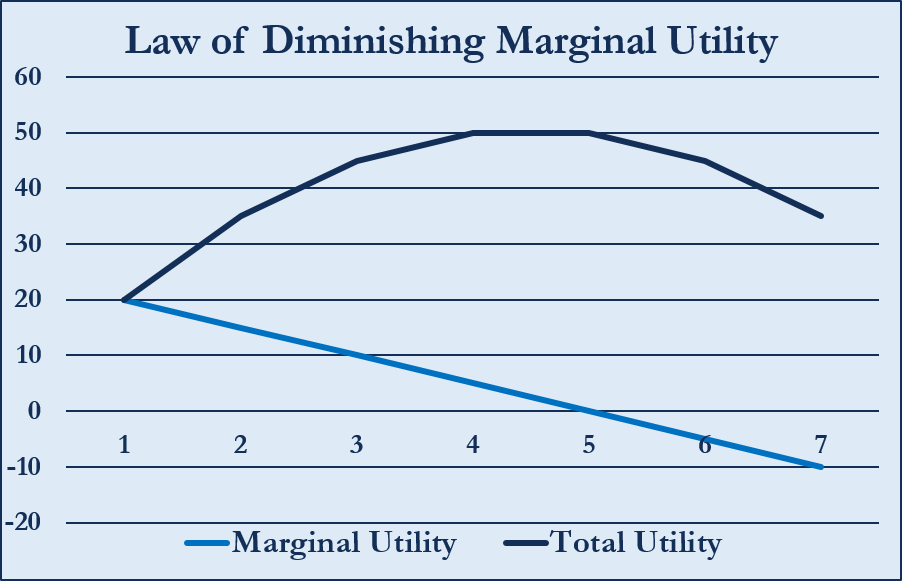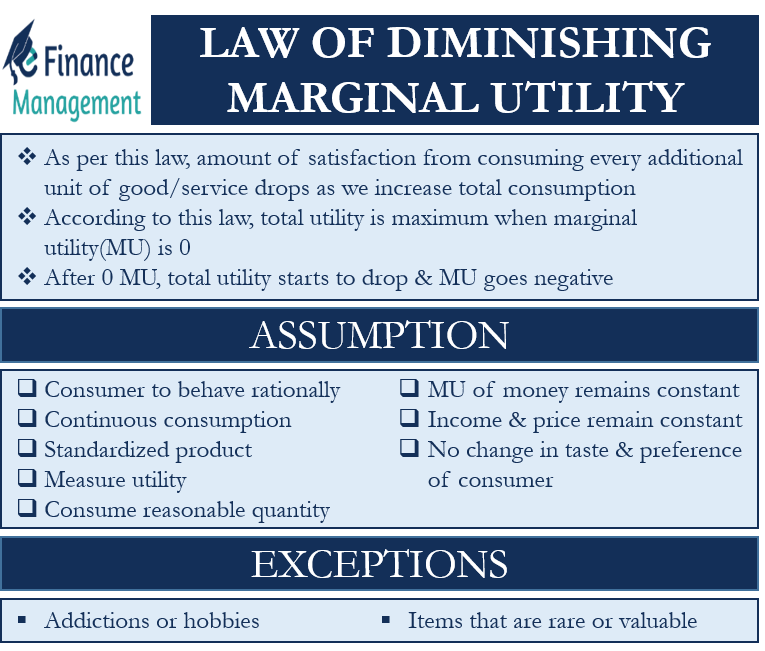What is the Law of Diminishing Marginal Utility?
The law of diminishing marginal utility is an economic concept that helps to explain human buying behavior. As per this law, the amount of satisfaction from consuming every additional unit of a good or service drops as we increase the total consumption. Or, we can say that as the consumption increases, the additional or marginal utility goes down with each additional unit.
In economics, the term utility refers to satisfaction or happiness. Total utility is also an economic term that tells the total satisfaction after consuming a unit of a product or service. Marginal utility is the change (increase or decrease) in the total utility after consuming an extra unit of good or service.
Explanation of Law of Diminishing Marginal Utility
In general, also, consuming the first unit of a commodity gives us the highest enjoyment or happiness. But as we consume more of the same commodity, after some time, we don’t feel the urge to consume more of it.
This is what the law of diminishing marginal utility is all about. The first unit of a product gives the highest level of utility. But the marginal utility drops with each subsequent intake of the commodity.
Also Read: Why Must Marginal Utility be Equal to Price?
Moreover, if the consumers want to know marginal utility by spending the same dollars on various commodities, it is called the law of equi marginal utility, which is also called an extension of the law of marginal utility.
We can also use a graph to explain the law of diminishing marginal utility. In the graph below, the X-axis shows the amount of units of a commodity that a consumer consumes. And the Y-axis shows the marginal utility of each unit.
The graph below shows the total utility and the marginal utility curves. The graph clearly shows that the total utility is maximum when the marginal utility is zero. This is because the MU is the slope of the total utility curve. After zero MU, the total utility starts to drop, and MU goes negative. A negative marginal utility implies that consuming more units will lead to dissatisfaction for the consumer.

The law of diminishing marginal utility also has a direct relation with the concept of diminishing prices. As the marginal utility of goes down, a consumer will be willing to pay a lower price for a product or service. For example, a consumer is willing to pay $20 for the first burger, but since he is no more after the first burger, they will be willing to pay a less amount for the second burger.
Example of Law of Diminishing Marginal Utility
Let us understand the law of diminishing MU with the help of a simple example.
Mr. A is very hungry, and he goes to a pizza store where he buys a very large pizza with 6 slices. The first slice of pizza gives him the maximum satisfaction, say 10. However, with the subsequent slices, Mr. A’s satisfaction keeps reducing as his stomach gets to fill. Or, we can say that the marginal utility for Mr. A diminishes as he consumes more pizza slices.
The following table shows Mr. A’s total utility and marginal utility.
| No. of Pizza Slice | Total Utility | Marginal Utility |
|---|---|---|
| 1 | 10 | 10 |
| 2 | 19 | 9 |
| 3 | 27 | 8 |
| 4 | 34 | 7 |
| 5 | 40 | 6 |
| 6 | 45 | 5 |
Law of Diminishing Marginal Utility: Assumptions
The law of diminishing marginal utility makes the following assumptions:
- Consumers need to behave rationally to maximize their utility with their limited income. It means that a consumer always makes sound decisions.
- Consumers need to continuously consume each extra unit of a commodity. It means that there shouldn’t be a pause between consumption. This is because if there is a gap in the consumption of two units, then the marginal utility may not drop. For example, if in the above pizza example, suppose Mr. A eats the third slice after a break or when he feels hungry again, the marginal utility, in this case, will increase.
- It is crucial that each unit of a product is standardized. This implies that the size, quality, and volume of each unit should be the same. In case of a deviation, the marginal utility may change. In the pizza example, if the second slice is smaller than the first one, then it is possible that Mr. A would get the same level of satisfaction as from the first.
- One can easily measure utility. Also, a consumer can tell their satisfaction level in absolute value, such as 1, 2, 3, etc.
- A consumer must consume the product in a reasonable quantity. For example, if a thirsty person drinks water with a spoon, then every additional spoon will increase the satisfaction level.
- The marginal utility of money remains constant. Usually, after spending money on the first unit, consumers are left with less money. The remaining money is generally dearer to the consumer. This will increase the MU for money for the consumer. But the law assumes there is no change in the MU for the money.
- The income of the consumer and the price of the commodity don’t change.
- There is no change in the taste and fashion of the consumer.

Exceptions
It is important to note that the law of diminishing marginal utility does not always hold. There are a few scenarios when this law doesn’t hold, and these are:
- In the case of Addictions/Hobbies, this law doesn’t hold. For example, a person who loves to paint may not witness a drop in marginal utility after a new painting. Similarly, for an alcoholic, an extra glass of alcohol may not decrease the marginal utility.
- Items that are rare or valuable are also an exception to this law. For example, if someone loves to collect a limited-edition watch, then they could continue collecting such items indefinitely without any drop in the marginal utility.
Apart from these two exceptions, there is criticism against this law as well. And this criticism is that the assumptions of the law of diminishing marginal utility may not always hold. For instance, a consumer may not always make a rational decision. And there can also be cases when there is a usual gap between the consumption of two units of a commodity.
Final Words
Despite the exceptions and criticism, the law of diminishing marginal utility is a very popular economics concept. Economists and exporters widely use this law to explain why consumers get less satisfaction with every additional unit. Moreover, companies also use this concept to increase the marginal utility of their products and services for consumers. This, in turn, help companies to increase their sales.
RELATED POSTS
- Law of Equi Marginal Utility – Meaning, Assumptions, and Importance
- Marginal Utility – Meaning, Importance, Factors, Types, and Graph
- Marginal Benefit – Meaning, Importance And More
- Consumer Equilibrium – Meaning, Example, and Graph
- Indifference Curve – Meaning, Features, Example, and Graph
- Ordinal Utility – Meaning and Assumptions

